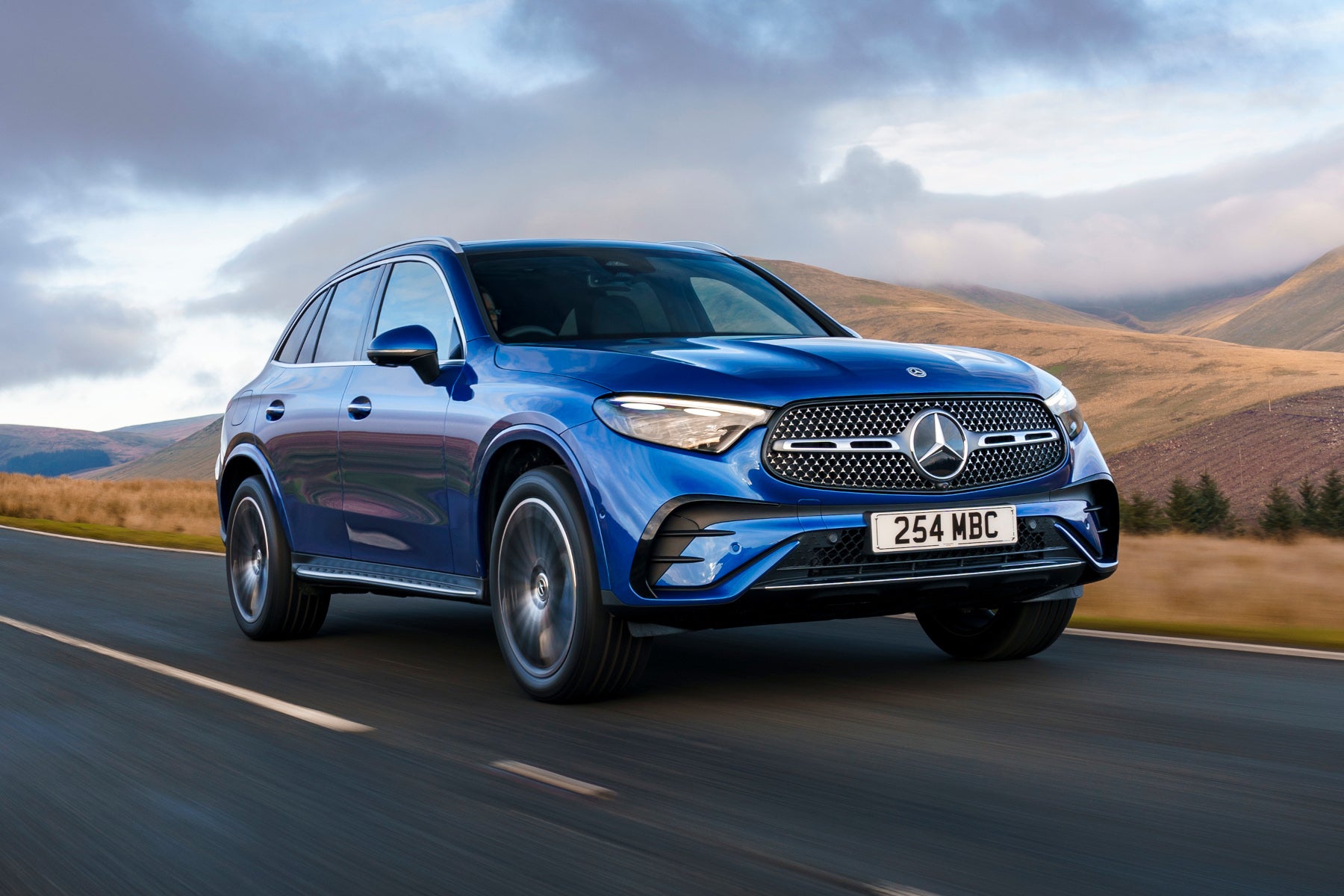Mercedes-Benz GLC Review 2025: Price, specs & boot space
Written by Lawrence Allan
Quick overview
Pros
- Glitzy, high-tech interior with lots of kit
- Plenty of space for people and luggage
- Impressive electric range on hybrid models
Cons
- Parts of the cabin are style over substance
- Prices are up considerably across the board
- Some rivals are better on the road
Overall verdict on the Mercedes-Benz GLC
"The Mercedes-Benz GLC sits slap bang in the middle of the brand’s SUV lineup, and the new second generation car should be a popular one. Classy, clever and with some impressive hybrid options, it’s only a shame that progress doesn’t come cheap. Our Mercedes-Benz GLC review finds out if it’s worth the premium pricing."
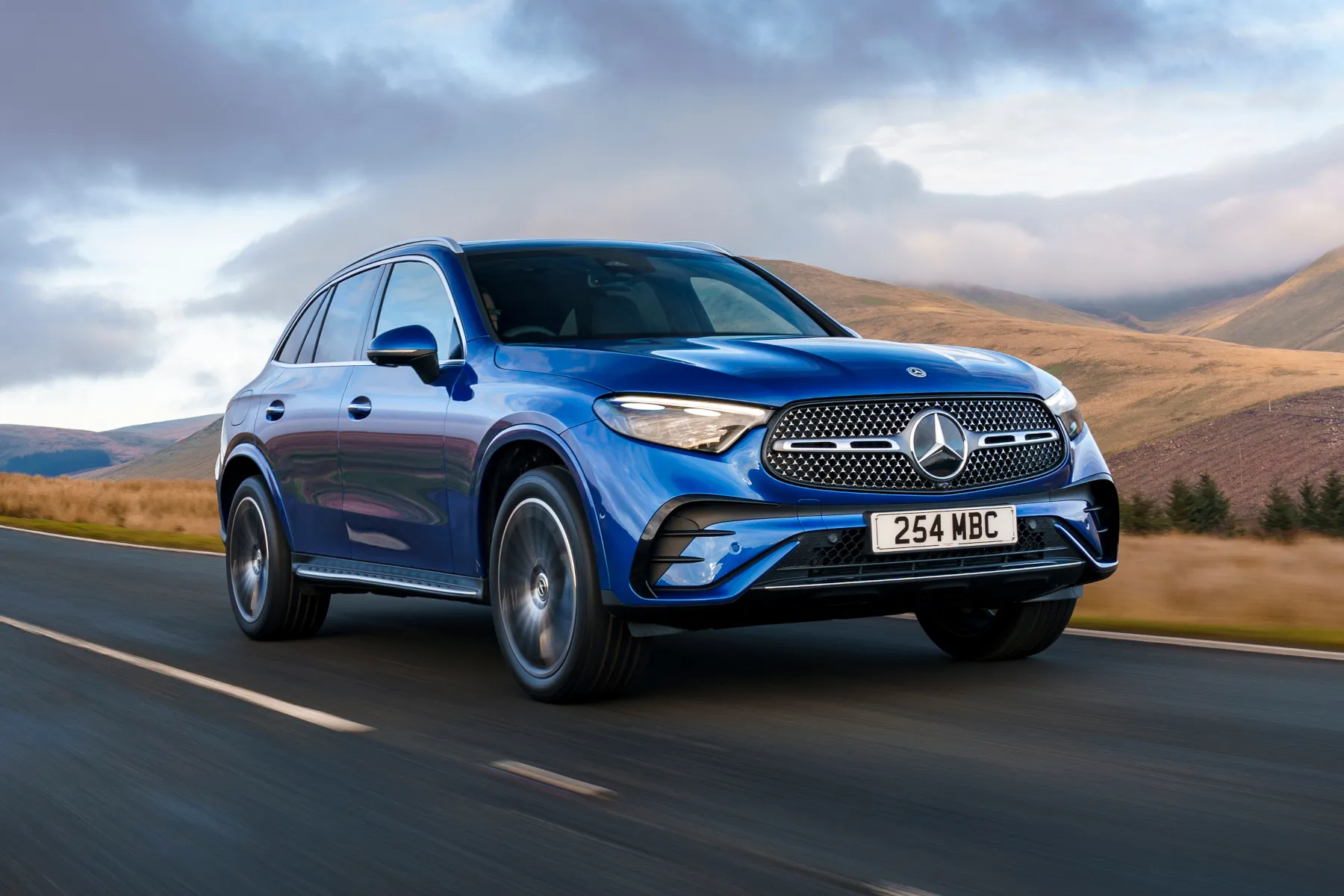
We wouldn’t blame you for being a bit confused by the sheer number of SUVs Mercedes-Benz offers. There’s a wide variety of high-riding models available to buy new with a mixture of petrol, diesel, hybrid and fully electric power. So how do you work it all out? Read our Mercedes-Benz GLC review to see if it's the one for you.
You might be more familiar with the brand’s traditional models which go up alphabetically in size and price (A-Class, B-Class, C-Class etc). So the ‘C’ in GLC translates to it being an SUV version of the C-Class, making it a mid-sized premium model.
Sitting below the bigger, pricier still Mercedes-Benz GLE, this second-generation GLC will no doubt be hugely popular as a rival to cars such as the Audi Q5 and BMW X3. The previous model was one of the brand’s biggest sellers globally, so Mercedes has pulled out all the stops to ensure it appeals to everyone.
That means an engine to suit every customer need. So there’s a pair of diesels for high mileage drivers, a punchy pure petrol model and - most importantly given the GLC is an in-demand company car - a petrol AND a diesel plug-in hybrid (PHEV). There's also the Mercedes-AMG GLC 43 and 63 models with up to a whopping 680PS of power on hand.
So far we’ve only driven the plug-in hybrid Mercedes-Benz GLC 300e. It’ll be a big business seller because of the low company car tax but also makes a good case for itself as a private car, particularly because its massive (for a PHEV) battery allows an all electric range of between 75 and 83 miles depending on usage, plus decent performance even without waking the engine. If you need even more electric range than this, consider the Mercedes EQC EV instead.
That’ll mean incredibly low fuel costs for those that can plug-in the 300e regularly, although you need to bear in mind that, at £59,000, it’s a lot more to buy in the first place than a GLC 300 petrol. In fact, pricing is a bit of an issue across the Mercedes-Benz GLC range.
What is unlikely to be an issue is the design. Where BMW is going for the shock and awe of challenging, controversial designs, Mercedes is delivering an evolved, elegant approach. Sure, it doesn’t look that much different from the old car, but it’s recognisably a posh German SUV and that’s what matters to many.
Inside, the GLC mirrors the upmarket, showy cabin design of the brand’s latest models such as the new C-Class. That means it’ll certainly impress any mates that hitch a lift, with cool ambient lighting and lots of clever tech, plus plenty of standard equipment across the range. We do have some reservations; sometimes the technology tries to be too clever for its own good, while some of the details inside aren’t as well-finished as in key German rivals.
On the road the new Mercedes-Benz GLC majors on comfort and refinement, particularly in hybrid form. Its very quiet and perfect for pottering about town or motorway cruising, although sometimes it gets unsettled by rougher roads. The sheer weight of the plug-in hybrid’s big battery means this certainly isn’t the most agile family SUV around, though - a Jaguar F-Pace or BMW X3 is more controlled and precise.
Sophisticated, refined and hugely efficient, the GLC PHEV is an extremely competitive addition to the hybrid SUV market.
Looking for a used car for sale? We've got 100s of Mercedes-Benz Approved Used Cars for Sale for you to choose from, including a wide range of Mercedes GLC cars for sale. If you’re looking for the older version, you need our Mercedes-Benz GLC (2015 to 2022) review.
Is the Mercedes-Benz GLC right for you?
If you can afford it and want a posh, comfortable SUV with the technology to match its image, the Mercedes-Benz GLC is a very worthy choice. It’ll also suit business users in plug-in hybrid form as the company car tax rates combined with electric-only running will save a fair bit of dosh.
It’s probably not the SUV of choice for keen drivers, however. If you want something that feels like a high-riding sports saloon you’ll be disappointed - although we’ve not yet driven the lighter pure petrol and diesel models that may feel more agile.
What’s the best Mercedes-Benz GLC model/engine to choose?
The plug-in hybrid petrol is one of the best examples of its type thanks to that super long electric range. Those that can charge at home or work will love it, but bear in mind it’s expensive and for many the saving in fuel costs won’t offset that price jump.
We reckon most private buyers will be served best by either the Mercedes GLC 220d diesel or the GLC 300 petrol. Both offer respectable on-paper performance, should be pretty refined and are much cheaper to buy or lease than the hybrids. Bear in mind that the petrol version will likely be pretty thirsty if you do lots of town driving, though.
What other cars are similar to the Mercedes-Benz GLC?
The Mercedes-Benz GLC’s toughest nuts to crack come from familiar places: yep, it’s those pesky German counterparts in the form of the Audi Q5 and BMW X3. The advantage the Mercedes has is that both those cars are getting on a bit now so aren’t as fresh. We’re expecting to see new versions of both in 2023, however.
Other cars that you should consider alongside the GLC include the new Lexus NX, the Volvo XC60 and the Jaguar F-Pace - all three offer good plug-in hybrid options too. Don’t discount the Mazda CX-60, which may not have the same clever tech and premium badge as the Merc but is usefully cheaper.
For petrol or diesel buyers you should also consider the Alfa Romeo Stelvio and Genesis GV70, while the CX-60 will be offered in straight-six petrol and diesel form sometime in 2023.
Comfort and design: Mercedes GLC interior
“The Mercedes-Benz GLC dazzles you with a feature-packed, tech-heavy cabin and cool ambient lighting. It certainly looks premium and is well-equipped, although some elements are a bit style over substance.”
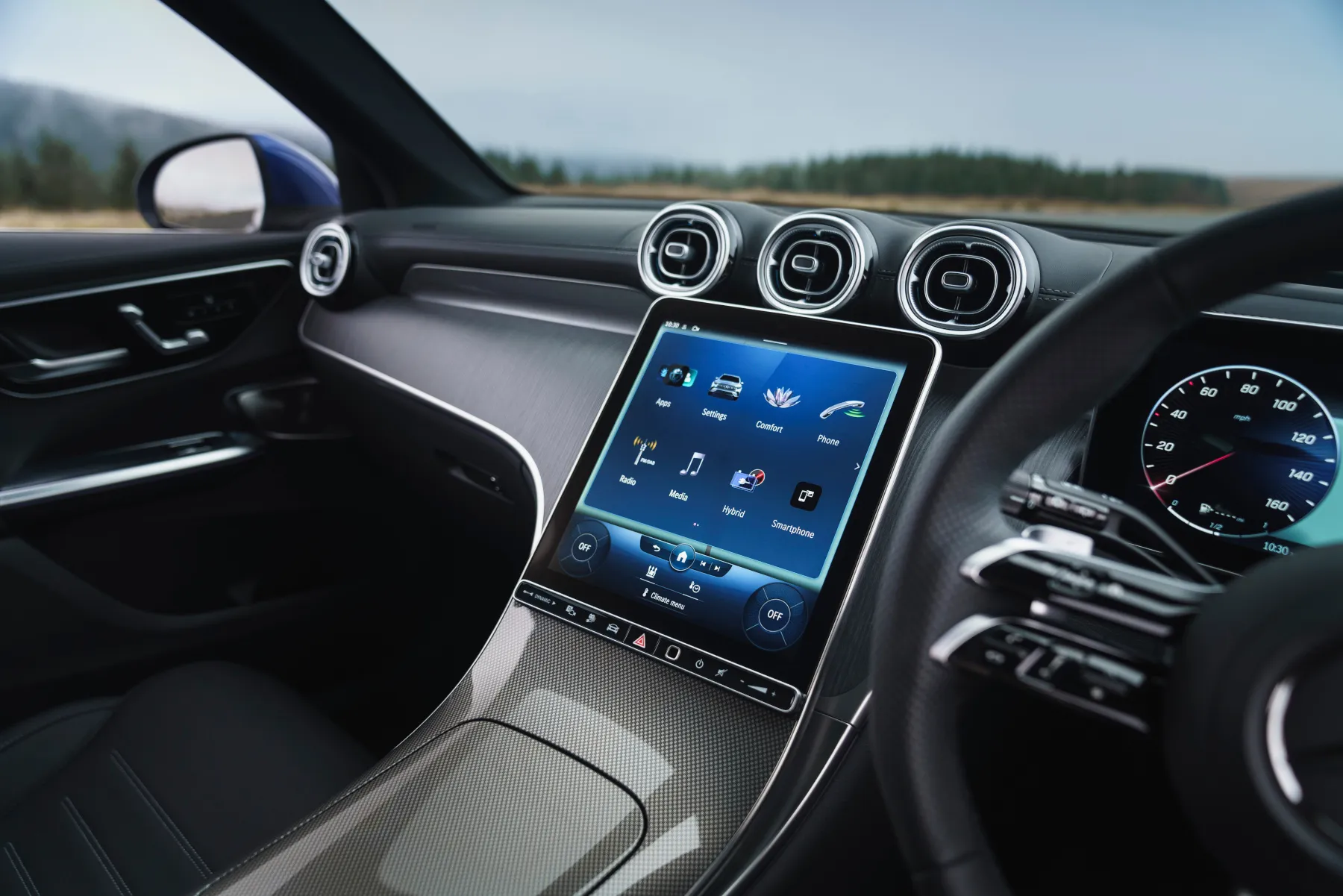
Anyone familiar with a modern Mercedes-Benz will know how the brand has gone in heavily on technology. This is evident as soon as you step inside the GLC, with its large portrait-angled infotainment screen, LED strips oozing ambient lighting from every possible crevice and slick digital dials. It’s a different approach to tech focus compared to Tesla, which goes with quite stark and minimalist interiors.
You even get fancy augmented reality navigation combined with a large head-up display on certain versions. There’s no doubting this cabin has a real wow factor, although the more you explore and poke around the more you realise that, in a few places, the actual fit and finish isn’t quite at Audi levels.
We’ve no complaints with the commanding driving position, which gives a good view out despite slightly obtrusive windscreen pillars. You don’t feel like you’re perched on it rather than in it like some SUVs, though, with a cocooning dashboard and a wide range of seat adjustment.
Quality and finish
You’d have to be incredibly cynical not to step in a modern Mercedes like the GLC and be impressed by the visual wow factor. Everything looks classy and neatly styled, with floating dash elements, soft-touch finishes and a cool overall design. It’s a lot more up-to-date than the previous generation car.
However, if you’re used to the sheer substance of underlying quality you’ll find in a BMW or Audi you might be slightly disappointed. There are some scratchier, less appealing plastics lower down the dash, while some of the switchgear isn’t as impressively finished as rivals. We’re being picky, but this is an expensive premium SUV and buyers will be too. Oh, and cool though that ambient lighting is, you’ll want to dim it at night so you can concentrate on the road rather than feel like you’re driving a Miami vodka bar.
Infotainment: Touchscreen, USB, nav and stereo in the Mercedes GLC
Until possible cheaper versions arrive all versions of the Mercedes-Benz GLC feature a pair of big displays. A 12.3-inch instrument display is complemented by a portrait-angled 11.9-inch infotainment screen in the centre of the dash in its own bezel, angled slightly towards the driver.
This being a modern Mercedes there’s a variety of ways to control it. It’s a touchscreen, with seriously sharp graphics and a responsive interface, while there’s also touch-sensitive controls on the steering wheel that complete basic functions. These are, sadly, really fiddly, making a simple task like changing track on your Spotify playlist infernally complex when you’re trying to concentrate on the move. Physical buttons would be much easier to use without taking your eyes off the road.
Still, there’s the Mercedes Me voice control system which is a lot better than some systems on the market. Say ‘hey Mercedes’ and it springs to attention, allowing you to ask for things like heated seats, changing the radio station or inputting a navigation address using natural speech. Like many of these systems you’ll find it activating when you don’t want to at times, though.
On the nav front, AMG Line Premium or Premium Plus models get a cool feature called Augmented Reality navigation. Just like in other more recent Mercedes models, it shows the car’s front camera feed on the centre screen and arrows or pointers to show you exactly which junction or roundabout exit to take. Plus they also do that on the head-up display, which sounds distracting but works really well.
Of course you can bypass much of the system with wireless Android Auto and Apple CarPlay that allows you to mirror smartphone apps like Spotify and Waze, while wireless phone charging is standard fitment.
Space and practicality: Mercedes-Benz GLC boot space
It might be a image-focused premium car but Mercedes hasn’t forgotten about the important stuff in the new GLC. Whether you’ve got a car full of adults or children it’ll excel as a family SUV.
Those up front have loads of legroom and a tremendously comfortable and adjustable driving position, so six-plus footers or broader built people up front will be more than happy. Headroom is good too even with the panoramic sunroof that comes on certain models.
Similarly a pair of six-plus footers can sit behind themselves with little cause for complaint. Legroom is plentiful, headroom is generous and there’s room to slide your feet under the front seats to stretch out. The large centre tunnel does hinder a middle seat passenger more than electric SUVs which usually have a flat floor, however. Interestingly the Mercedes GLC is not a seven-seater, but the smaller Mercedes GLB is.
Storage aboard the GLC is pretty impressive, too. Cupholders are hidden under a neatly sliding tray in the centre console and have pop out holders that snugly grip your cup or bottle, while bigger bottles will fit in the door bins front and rear. There’s also a cubbyhole under the armrest, a decent-sized glovebox, map holders on the back of the front seats and pop-out cupholders in the rear armrest that also feature a little phone holder.
The Mercedes-Benz GLC’s boot capacity of 620-litres is bigger on paper than most rivals and a good shape, with buttons in the rear to fold the seats down easily. However, we’ve only seen the plug-in hybrid one so far. That reduces the capacity substantially to 470-litres, with no underfloor storage and a higher boot floor. With the seats folded, you get 1680-litres of capacity, dropping to 1530 with the PHEV versions. That’s the price you pay for that class-leading battery.
In terms of exterior dimensions the new Mercedes-Benz GLC is 4716mm long, 2096mm wide including mirrors and 1640mm tall. That makes it identical in width and 4mm lower in height than the old car, but it’s 61mm longer.
Handling and ride quality: What is the Mercedes-Benz GLC like to drive?
“The Mercedes-Benz GLC continues to focus on comfort over agility, which is something we think SUV buyers will value. It’s not perfect, though.”
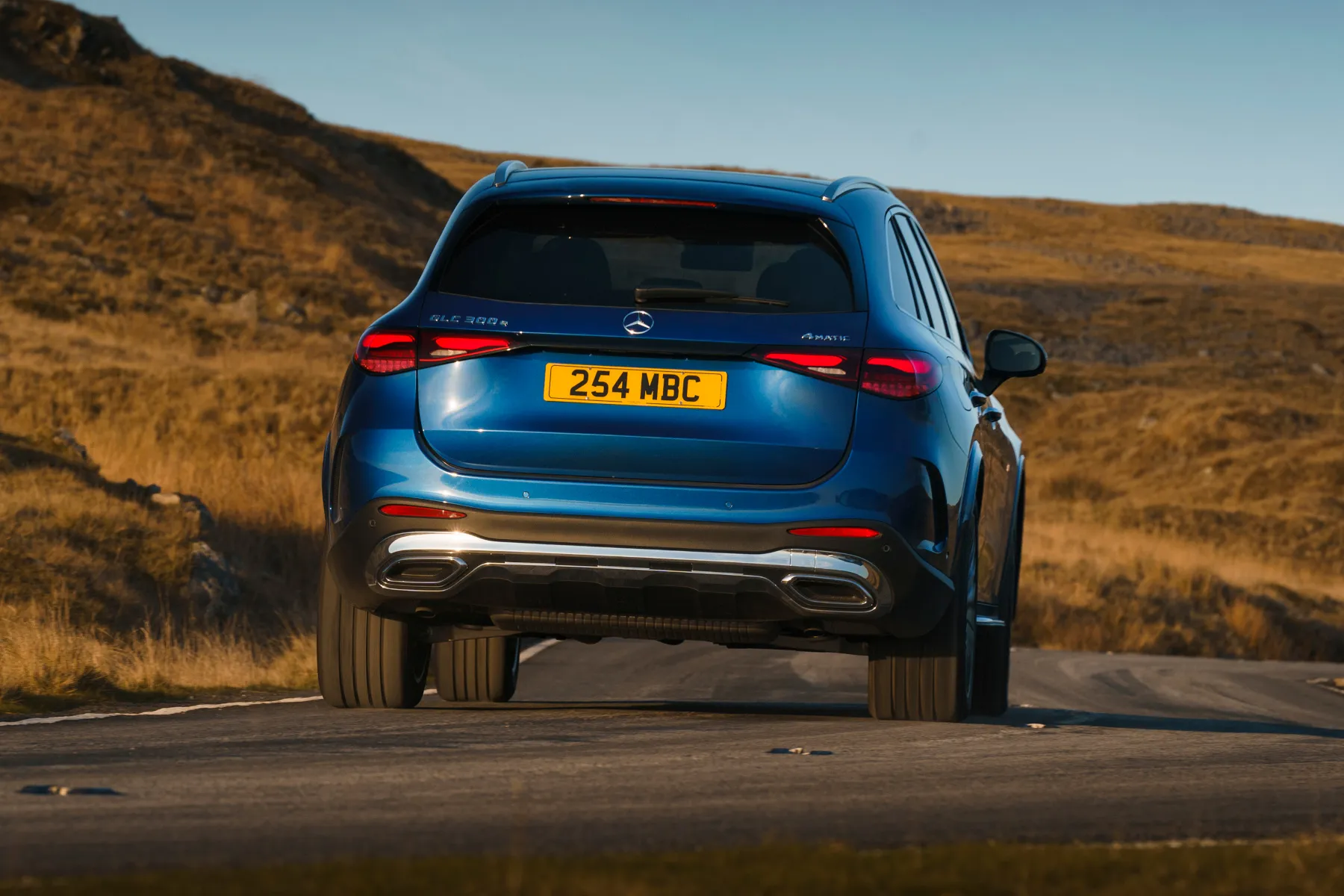
Mercedes-Benz has a habit of making suspension setups vary wildly depending on which version you choose. Things are a bit simpler at the moment with the GLC.
Because the only trim levels available are AMG Line-based, the petrol or diesel Mercedes GLCs get sports suspension as standard. We’ve not yet tried this - generally the brand’s sportier setups are still pretty comfortable, but we’ll have to get back to you on that.
The plug-in hybrid models get a different setup with self-levelling air suspension at the rear and traditional springs at the front. Some markets get full, all-corner air suspension that isn’t available in the UK for some reason, but we’ve only tried the standard PHEV setup. The reason why it has rear air suspension is to control the (gulp) 2.3 tonne kerbweight, which makes it the heaviest of all the plug-in hybrid SUVs in this class.
It generally seems pretty comfortable and composed on the road unless you drive about like your hair’s on fire. Big bumps and speed humps around town are dealt with well and there isn’t too much bobbing and wallowing as you get down the road, although it is clearly quite soft.
The result of this softness is it struggles with more undulating, bumpy faster roads, where the ride can be a bit unsettled and the car leans quite a bit in the bends. You can mitigate this by putting the car into Sport mode, but sharp bumps then make themselves felt and heard more. Annoyingly it seems you can’t have the engine and gearbox in Sport but set the suspension to Comfort - it’s one or the other. Still, the steering is direct and weighty enough while still being light in town.
A lower, lighter Mercedes C-Class is better all-round, riding more smoothly while staying more level in the bends. But people buy SUVs because that’s what they want, and in the context of this class the GLC isn’t bad at all. Having said that, we reckon an equivalent BMW X3 or Jaguar F-Pace is just that bit nicer to drive in every situation.
There is also the Mercedes-AMG GLC models - 43 and 63 - that come with larger alloy wheels, AMG RIDE CONTROL suspension, and selectable driving modes. As you'd expect, they deal with bumpy roads in a firmer manner than the other GLC models, but pay back with even more grippy cornering habits.
The optional Driving Assistance Package Plus seems like a no-brainer if you commute. It can drive the Mercedes down an A road or motorway with spooky efficiency accelerating, steering and braking for you. It follows speed limits and can slow for corners and junctions automatically. If the road gets congested, it can drive you in stop-go queues and even pulls to the outside of the road automatically to let emergency vehicles get to an accident.
What engines and gearboxes are available in the Mercedes-Benz GLC?
There is a choice of two diesels, one petrol and two plug-in hybrids, plus two performance AMG versions. The non-PHEV models all still have a 48-volt mild-hybrid system. Some markets also get a third plug-in hybrid option, too.
So far we’ve only tested the GLC 300e petrol plug-in hybrid and it’s a respectable setup. It has 3013PS from a 2.0-litre turbo petrol engine mated to an electric motor. 0-62mph comes up in 6.7 seconds, with useful if not thrilling performance and a surprisingly rorty engine note when you give it the beans. Standard all-wheel drive means it gets off the line well in all conditions, too.
Its performance is always boosted by the electric motor with its decent 136PS output. You feel that instant electric punch off-the-line as it kicks in before the engine and gearbox can react, while it’s not too difficult to keep it in electric power unless you’re really ham-fisted with the throttle. Top speed without the engine running is a useful 87mph.
Interesting the GLC 300de diesel plug-in puts out even more power, up to 333PS from it’s 2.0-litre diesel and electric motor combo. 0-62mph is dispatched even more quickly in 6.4 seconds.
Even the pure petrol model is no slouch. This 2.0-litre four-cylinder puts out a ‘mere’ 258PS (plus 23PS from the mild-hybrid system) but because it’s so much lighter than the hybrids it’ll do 0-62mph in 6.2 seconds.
Meanwhile, the entry-level GLC 220d 2.0-litre four-cylinder diesel makes do with 197PS (plus that 23PS) for a 0-62mph time in eight seconds dead, while the GLC 300d (the same engine in a higher state of tune) puts out 269PS plus 23PS for a 0-62mph time of 6.2 seconds.
Then we have the full-on AMG models that use a 2.0-litre turbo petrol engine and electric motor to offer 421PS in the 43 model and a heart-pounding 476PS in the 63 model. You won't be shocked to learn this pair offer 0-62mph in 4.8- and 3.5 seconds respectively.
All versions of the Mercedes-Benz GLC come with 4Matic all-wheel drive as standard, and a nine-speed automatic gearbox. To avoid hesitation when you suddenly demand power the plug-in hybrids use electric power to fill in while the gearbox chooses the right gear.
Refinement and noise levels
The Mercedes GLC’s refinement seems generally pretty good on these initial impressions, with the caveat that we’ve only driven the plug-in hybrid. Of course that is as smooth and serene as you’d imagine around town with gearless, silent running.
On the motorway wind noise is well isolated for an SUV and road noise isn’t too intrusive either. The suspension isn’t as calm as the lower, lighter C-Class, however, with more thumps and body movement - but this could be the hybrid’s weight penalty again.
The AMG models are a bit noisier on their larger wheels with firmer suspension, and there's a bit more engine roar under hard acceleration that most buyers of these cars will be only too pleased to hear.
Safety equipment: How safe is the Mercedes-Benz GLC?
The Mercedes-Benz GLC has been crash tested by Euro NCAP and achieved the maximum five-star safety rating. High scores across the board makes it a strong all-rounder, although some SUV rivals are slightly better in certain areas.
Standard safety kit includes automatic emergency brakes in both forward and reverse, active lane assist that keeps you in lane, a blind spot warning system and a bonnet that pops up in an impact to protect pedestrians from the hard engine below. You of course get a load of airbags
You can boost safety even further by opting for the Driving Assistance Package Plus, which adds active cruise control that can steer the car around corners and operate the car's accelerator and brakes.
MPG and fuel costs: What does a Mercedes-Benz GLC cost to run?
"The Mercedes-Benz GLC gets mild or plug-in hybrid power across the range, so for now there's no really thirsty models. The PHEVs are incredibly efficient."
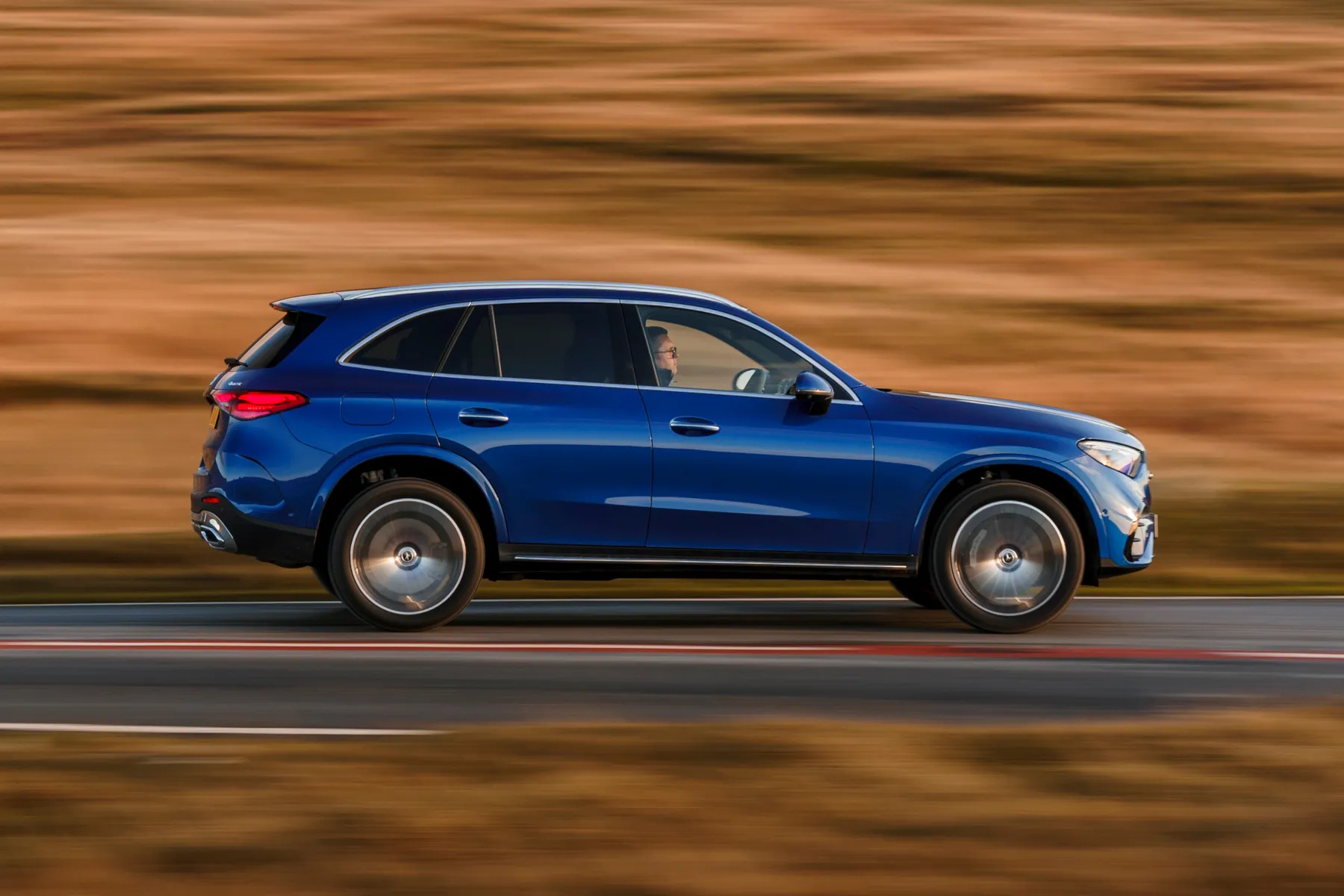
It probably won’t surprise you to learn that the Mercedes-Benz GLC 300e plug-in hybrid is extremely efficient on paper. In fact, it’s one of the most frugal PHEVs ever made.
Its WLTP-rated fuel economy figure is 470.8mpg (no, that isn’t a typo) while it emits a mere 13g/km of CO2. The range rating of over 60 miles from a full charge means it’ll fall into a lower company car tax band than a number of plug-in rivals, too. In our experience in cold conditions, 60 miles is just about achievable, but in warmer weather when batteries perform better expect to beat that.
Think that’s impressive? You haven’t seen the GLC 300de plug-in, which has a similar all-electric range mated to a diesel engine for a bonkers 565.0mpg and CO2 emissions of just 11g/km.
Don’t buy into the official figures without considering your use cases, though. Run out of battery and have nowhere to charge it? Those official MPG figures will quickly plummet by more than 90%. For those without regular access to chargers or who regularly travel more than 100 miles in one sitting we simply cannot recommend spending the extra on either.
Indeed the regular GLC 220d diesel will likely be more efficient on a long journey than the PHEV with a depleted battery. Officially it manages 52.3mpg, not bad for a heavy car with four-wheel drive. The GLC 300 petrol manages 37.2mpg combined which is quite a bit less, but still decent enough.
Both these petrol and diesel models are still hybrids in the technical sense, receiving a 23PS boost from a 48-volt mild-hybrid system that makes the stop/start more effective and means you rely a bit less on the engine when you pull away.
How reliable is the Mercedes-Benz GLC?
The Mercedes-Benz GLC is a relatively new car and it’s difficult to accurately assess its reliability at this stage. The brand itself finished respectably in the mid-table of our latest HonestJohn.co.uk Satisfaction Index, although it was beaten by all of tis key premium rival brands.
Insurance groups and costs
The Mercedes-Benz GLC is a relatively expensive new car and insurance groups reflect that. Even the base diesel model sits in a high group 40, with the 300 petrol in group 42.
The plug-in hybrids, meanwhile, range from group 47 to group 50 - the maximum ranking that’s comparable with luxury cars and supercars. It’s also around 7 groups higher spec-for-spec than the C-Class saloon on which it’s based, interestingly.
The AMG models start in group 45 and go all the way up to group 50, but then you probably expected that.
VED car tax: What is the annual road tax on a Mercedes-Benz GLC?
As you’re unable to buy a Mercedes-Benz GLC for less than £40,000 new you’ll be stuck paying the £410 a year ‘premium car’ tax on top of the regular road tax (VED) for five years.
Happily none of the engines are particularly inefficient. The GLC 300 petrol is the worst offender which is hit with a £1095 first year rate, while both diesels cost a more reasonable £270 in the first year. The stars of the show are the hybrids, both of which have a first year tax rate of only £10.
All models default to the £190 a year flat VED rate after that, although the hybrids get another £10 discount.
How much should you be paying for a Mercedes-Benz GLC?
"The Mercedes-Benz GLC sits right at the top of the segment as a new car, and the hybrids command quite the premium."
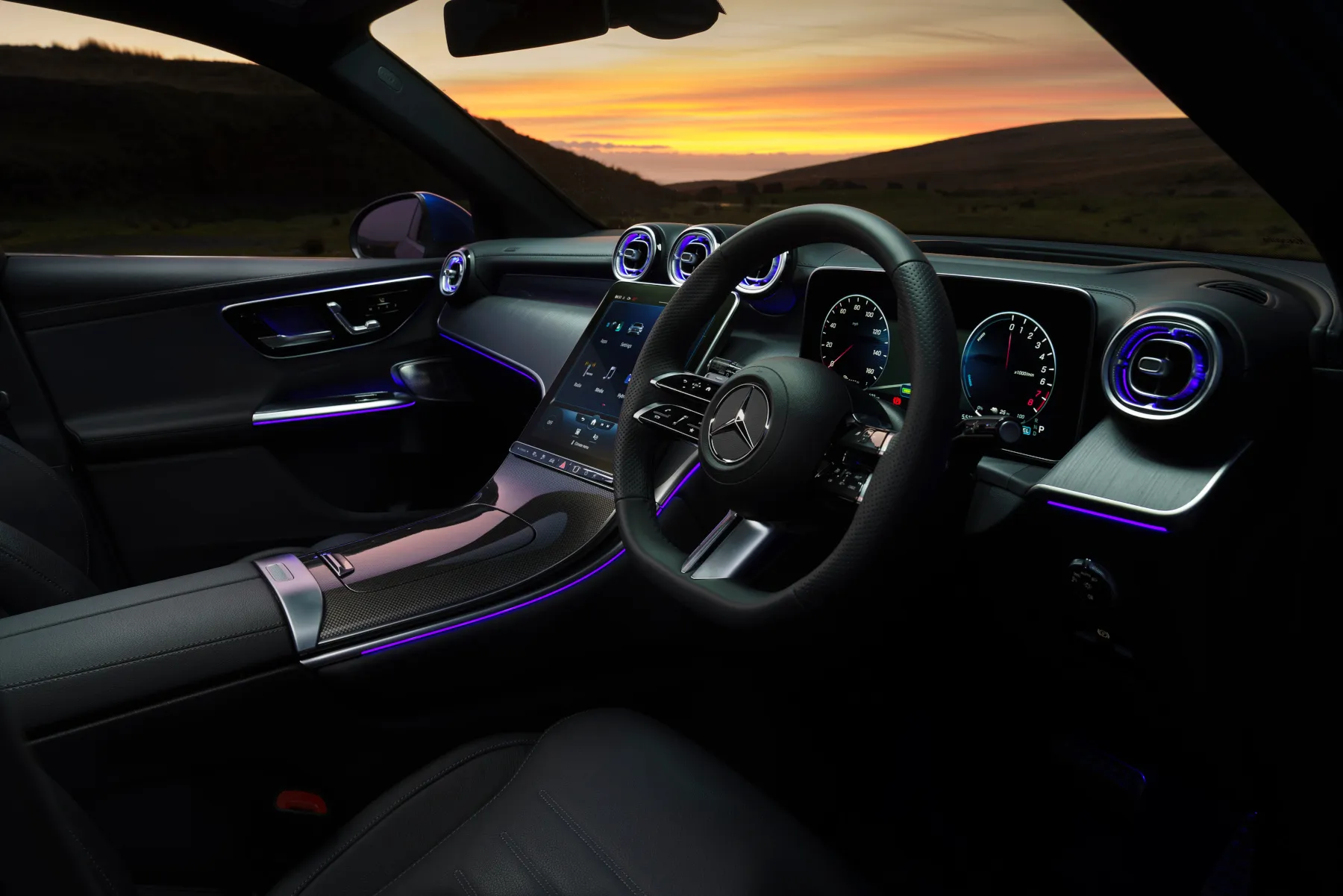
Prices for the new Mercedes-Benz GLC start at a fairly eye-watering £52,895 for the GLC 220d 4MATIC AMG Line. That's substantially more expensive than the starting price of the old model, but then again there isn't really an 'entry-level' model as all versions come highly specified. All key rivals can be had for less, however.
Stepping up to the GLC 300 petrol in the same trim will see you pay £54,945, while AMG Line Premium trim adds £5000. The GLC 300 d only comes in AMG Line Premium and AMG Line Premium Plus forms and costs from £61,805. Perhaps the most painfully expensive are the AMG Line Premium Plus models which cost between £62,895 and £75,610 depending on spec. That used to be large SUV money.
Mercedes has softened the blow for the GLC 300e and 300de models with the Urban Edition trim. This brings these models' entry prices to £58,860 for the petrol and £61,110 for the diesel.
At the other end of the spectrum, we have have the GLC 43 from £73,190 and the 63 starting at a slightly unhinged £109,030.
Of course leasing will make these figures easier to swallow with monthly payments, but it'll be surprising if the GLC is cheaper than rivals there. It'll be interesting to see if cheaper trim levels arrive later.
Trim levels and standard equipment
The Mercedes-Benz GLC is available in for trim levels, plus the standalone AMG versions.
The entry-level Mercedes-Benz GLC Urban Edition for the GLC 300e and 300de. It comes with 20-inch alloy wheels, AMG Line exterior, LED headlights, roof tails in black, chromed twin exhaust pipes. You also get an AMG Line interior with Seat Comfort pack, electric seat adjustment, climate control, wireless charging, cruise control, and the Parktronic active parking assist and reversing camera.
Next is the AMG Line with standard-fit 19-inch alloys, privacy glass, AMG bodystyling elements, sports seats in combination man-made leather and suede-like upholstery with front seat heating, LED headlights with auto high beam, 64 colour ambient lighting, the full infotainment suite and wireless phone charging and front and rear parking sensors. It also has a powered tailgate for added convenience.
Mercedes-Benz GLC AMG Line Premium models add more kit, with 20-inch alloy wheels, plus matrix beam Digital Lights that can shape their beam to the road and around other road users.
There's also heat and noise-insulating glass, illuminated door sills, keyless go and access, memory electric front seats, blind spot assist, a built-in dashcam, augmented reality navigation, a 360-degree camera system and Traffic Sign Assist.
Stepping up to top-spec Mercedes-Benz GLC AMG Line Premium Plus brings 20-inch multi-spoke wheels, while the the Digital Light system gains a projection function that can display directions or instructions on the road. You also get a panoramic glass sunroof, four-zone climate control, a Burmester sound system with 13 speakers, a head-up display and full leather.
The AMG performance models come with 20- and 21-inch wheels for the GLC 43 and 63 respectively. There's also AMG RIDE CONTROL suspension, selectable drive modes, AMG body kit styling, privacy glass, rear axle steering for sharper handling, and panoramic glass sunroof.
Ask the heycar experts: common questions
How much does a Mercedes GLC cost?
Which is better, the Mercedes GLC or GLE?
Which is bigger, the Mercedes GLC or the BMW X5?
Get our latest advice, news and offers
Keep me updated by email with the latest advice, news and offers from heycar.
By submitting you agree to our privacy policy
